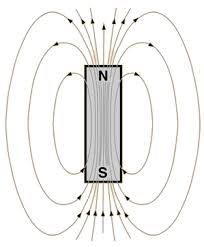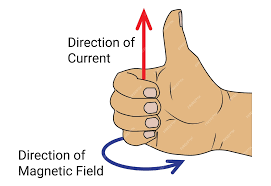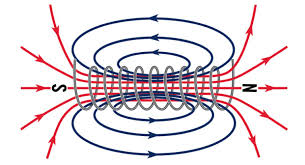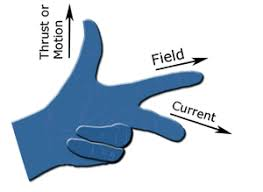Magnetic Effects Of Electric Current
12.1 Magnetic Field and Field Lines:
Magnets and their effects: We start with the familiar concept of magnets. You probably remember playing with magnets as a child, observing their ability to attract or repel each other. This force of attraction or repulsion is due to the magnetic field that surrounds every magnet. A compass needle, which is itself a tiny magnet, aligns itself with the Earth's magnetic field, helping us navigate.
Visualizing the magnetic field: To understand magnetic fields better, we use magnetic field lines. These are imaginary lines that map out the direction and strength of the magnetic field. The lines emerge from the north pole of a magnet, curve around, and enter the south pole, forming continuous loops. The closer the lines are to each other, the stronger the magnetic field at that point.
Magnetic field inside a magnet: It's important to remember that the magnetic field doesn't just exist outside the magnet. Inside the magnet, the field lines continue from the south pole to the north pole, completing the loop.

12.2 Magnetic Field due to a Current-Carrying Conductor:
Oersted's discovery: A major breakthrough in understanding electromagnetism came when Hans Christian Oersted discovered that an electric current flowing through a wire creates a magnetic field around it. This was a groundbreaking observation, linking electricity and magnetism in a fundamental way.
Right-hand thumb rule: To determine the direction of the magnetic field around a current-carrying wire, we use the right-hand thumb rule. If you imagine grasping the wire with your right hand, with your thumb pointing in the direction of the current, your fingers will curl around the wire in the direction of the magnetic field.

Magnetic field patterns: The shape of the magnetic field depends on the shape of the conductor. For a straight wire, the magnetic field lines are concentric circles around the wire. For a circular loop of wire, the field lines resemble that of a small bar magnet.
Solenoids: A solenoid is a coil of wire. When current flows through it, the magnetic fields of individual loops add up to create a strong, uniform magnetic field inside the coil. This makes solenoids essential components in devices like electromagnets, relays, and inductors.

12.3 Force on a Current-Carrying Conductor in a Magnetic Field:
Force and motion: When a current-carrying conductor is placed in a magnetic field, it experiences a force. This force is the basis for the operation of electric motors, where the interaction between the magnetic field and the current in the wire causes the motor to rotate.
Fleming's left-hand rule: To find the direction of the force on the conductor, we use Fleming's left-hand rule. If you stretch the thumb, forefinger, and middle finger of your left hand so they are mutually perpendicular, the forefinger points in the direction of the magnetic field, the middle finger in the direction of the current, and the thumb 1 gives the direction of the force.

Factors affecting the force: The strength of the force depends on the strength of the magnetic field, the amount of current in the wire, and the length of the wire that is within the magnetic field.
12.4 Domestic Electric Circuits:
Electricity in our homes: This section deals with the practical application of electricity in our daily lives. The electricity that powers our homes is typically supplied at 220V in India. This voltage is dangerous, so it's important to understand how electricity is distributed and used safely in our homes.
Wiring and safety: The electrical wiring in our homes consists of three wires: live, neutral, and earth. The live wire carries the current to the appliances, the neutral wire completes the circuit, and the earth wire provides a safety path for the current to flow in case of a fault.
Parallel circuits: Appliances in our homes are connected in parallel. This ensures that each appliance receives the full voltage and that the failure of one appliance doesn't affect the others.
Fuses: Fuses are safety devices that protect circuits from overload. If the current flowing through the circuit exceeds the fuse's rating, the fuse melts, breaking the circuit and preventing damage to appliances or even fire.
